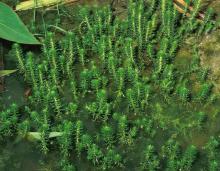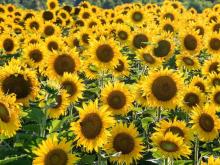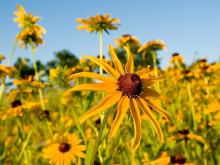Wildflowers, Grasses and Other Nonwoody Plants
Media

Species Types
Scientific Name
Myriophyllum spp.
Description
Water milfoils are feathery aquatic plants that grow rooted in shallow water. Their tips emerge above the waterline and bear bladelike, toothed leaves.
Media

Species Types
Scientific Name
Thaspium trifoliatum
Description
One of our more challenging plants to identify, meadow parsnip looks an awful lot like golden Alexanders. But you can do it! Look closely at the flower clusters and at the edges of the leaves, and then check the seeds.
Media

Species Types
Scientific Name
Helianthus annuus
Description
Whether you see the wild form or any of the many cultivated varieties, this poster child of the sunflower family cultivates its own sunny impression. Common sunflower is also the state flower of Kansas.
Media

Species Types
Scientific Name
Rudbeckia triloba
Description
Brown-eyed Susan is a bushy perennial with much-branching stems and plenty of flowerheads. Compared to Missouri’s other Rudbeckia species, its flowerheads are the smallest, growing to only about one inch across.
Media

Species Types
Scientific Name
Rudbeckia hirta
Description
Black-eyed Susan is a tremendously popular native wildflower for gardening. It’s also commonly planted along roadways, so when it’s blooming, May through October, you’re sure to see it somewhere.
Media

Species Types
Scientific Name
Helianthus spp.
Description
Most people recognize sunflowers when they see them, with their bright yellow ray flowers and rather flattened center of dark disk flowers. There are 16 species of Helianthus in Missouri.
Media

Species Types
Scientific Name
Scrophularia marilandica
Description
Eastern figwort occurs statewide in rich woods, woodland borders, and bottomlands. It’s usually 2-5 feet high, has square stems and lance-shaped, toothed leaves, and bears spreading clusters of small, green scoop-shaped flowers with brown petal lobes.
See Also
About Wildflowers, Grasses and Other Nonwoody Plants in Missouri
A very simple way of thinking about the green world is to divide the vascular plants into two groups: woody and nonwoody (or herbaceous). But this is an artificial division; many plant families include some species that are woody and some that are not. The diversity of nonwoody vascular plants is staggering! Think of all the ferns, grasses, sedges, lilies, peas, sunflowers, nightshades, milkweeds, mustards, mints, and mallows — weeds and wildflowers — and many more!





















